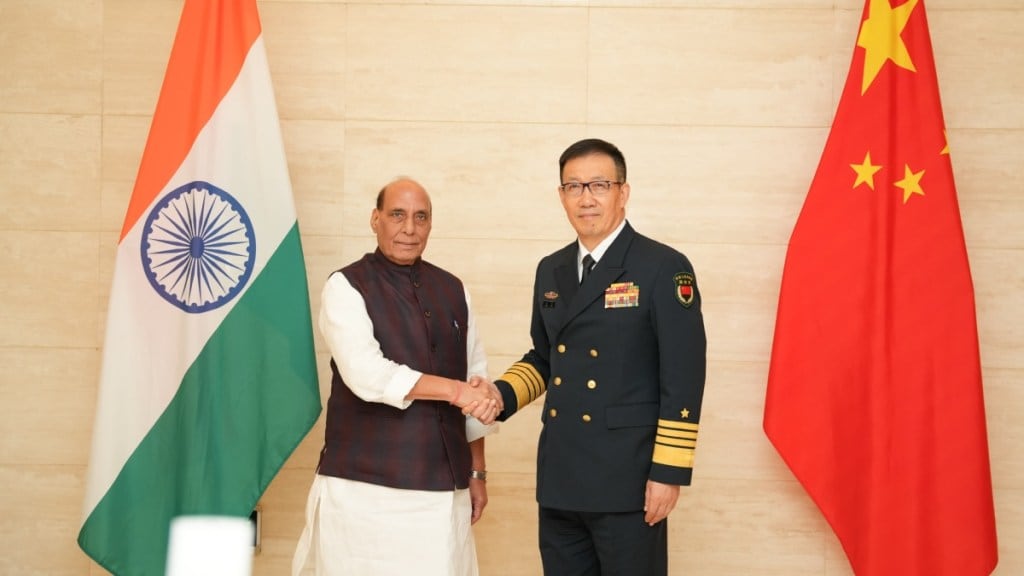On November 20, 2024, Indian Defence Minister Rajnath Singh held an important meeting with Chinese Defence Minister Admiral Dong Jun in Vientiane, Laos, on the sidelines of the 11th ASEAN Defence Ministers’ Meeting-Plus (ADMM-Plus). This marked the first face-to-face conversation between the two ministers since recent disengagement agreements aimed at reducing military tensions along the Line of Actual Control (LAC), following years of strained relations due to border conflicts.
According to an official statement issued by the Ministry of Defence on Wednesday, the discussions primarily focused on the current situation at the LAC and the future direction of India-China relations. Minister Singh made it clear that friendly ties between the two nations, which are both large and influential on the global stage, would have far-reaching positive effects. He stressed that “we need to focus on cooperation rather than conflict,” signalling India’s preference for constructive engagement over further confrontation.
Key Topics
One of the key topics was the need to prevent the recurrence of violent border clashes, such as those that occurred in 2020, which saw both sides suffer casualties. Singh pointed out the lessons learned from those clashes, urging both countries to take tangible steps to prevent similar incidents in the future. The Indian Defence Minister expressed a strong desire for greater trust-building between the two sides, which he argued could be achieved through continued de-escalation efforts along the border. Both India and China agreed to work on a roadmap to rebuild mutual understanding and reduce military tensions over time.
The timing of this meeting comes shortly after a series of diplomatic interactions between India and China. Just two days before, Indian External Affairs Minister S Jaishankar met his Chinese counterpart, Wang Yi, on the margins of the G20 summit in Brazil. Jaishankar expressed satisfaction with the progress of the disengagement process, noting that both sides had followed through with the agreements made at the LAC.
The meeting between Singh and Dong probably focused on the specifics of this disengagement process, especially in areas like Depsang Plains and Demchok, where troops had recently been withdrawn or repositioned.
India’s primary goal in these discussions is to secure broader de-escalation along the entire LAC. This would involve the withdrawal of additional troops stationed since the 2020 military standoff, a key point of focus for both governments as they seek to reduce the risk of further confrontations. The agreement to restart patrols in areas like Depsang Plains, which saw its first joint patrols in November 2024, has provided some initial momentum in this process.
While the military dialogue between the two nations continues, the role of China’s Defence Minister remains somewhat symbolic. Unlike Defence Ministers in democratic countries like India or the United States, the Chinese Defence Minister does not directly command military forces. This authority lies with the Central Military Commission (CMC), headed by President Xi Jinping.
Admiral Dong, who took over in late 2023 after a period of leadership instability in the Chinese military, has limited direct influence over military decisions. However, as the public face of China’s military diplomacy, Dong plays a crucial role in shaping the country’s defence relationships with other nations.
Singh’s visit to Laos and his meeting with Admiral Dong underscore a critical phase in the India-China relationship, which has fluctuated between tension and cooperation in recent years. Both countries, as key players in global geopolitics, understand that their relationship holds implications not only for Asia but for global peace and stability. By focusing on diplomatic engagement and de-escalation, both sides are signaling their willingness to turn a new page in their complex bilateral relationship. If the progress made in recent months continues, there is hope that India and China may find a way to balance competition with collaboration, fostering a more peaceful and cooperative future for both nations.


